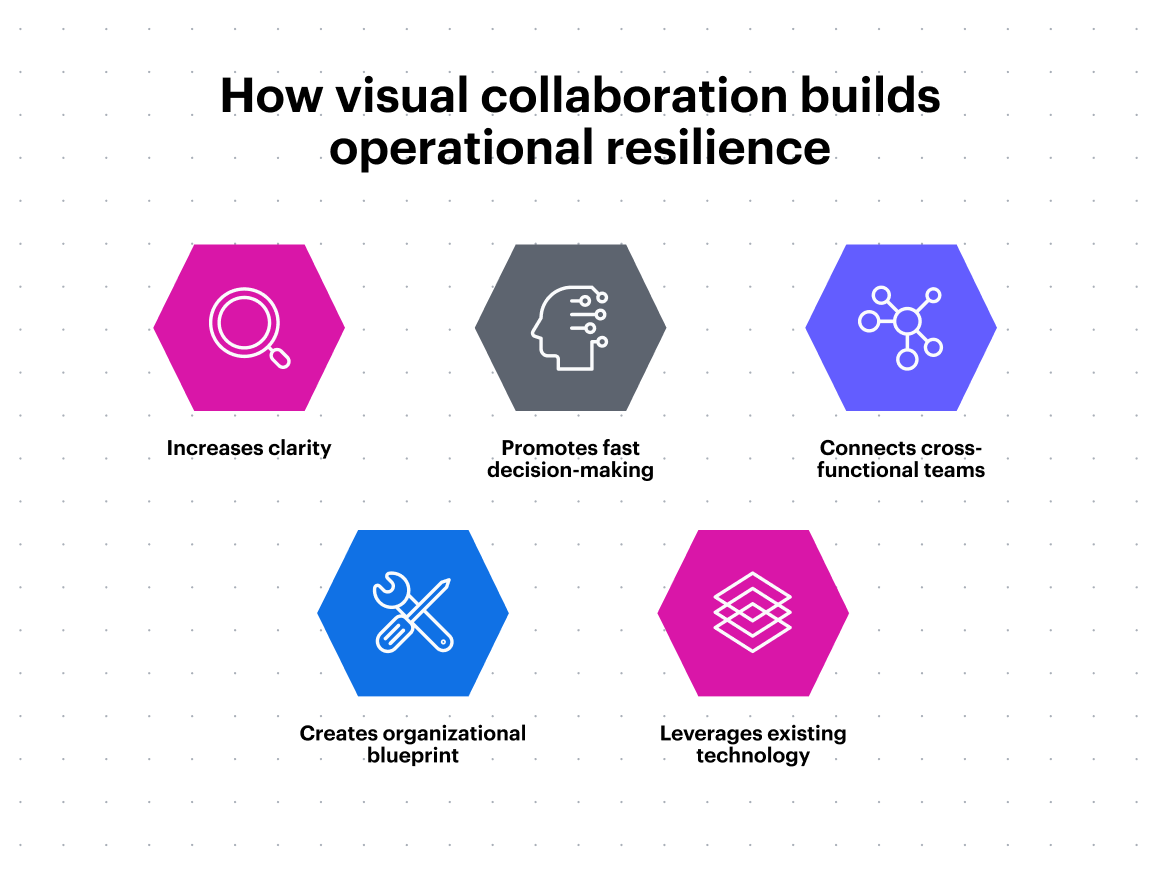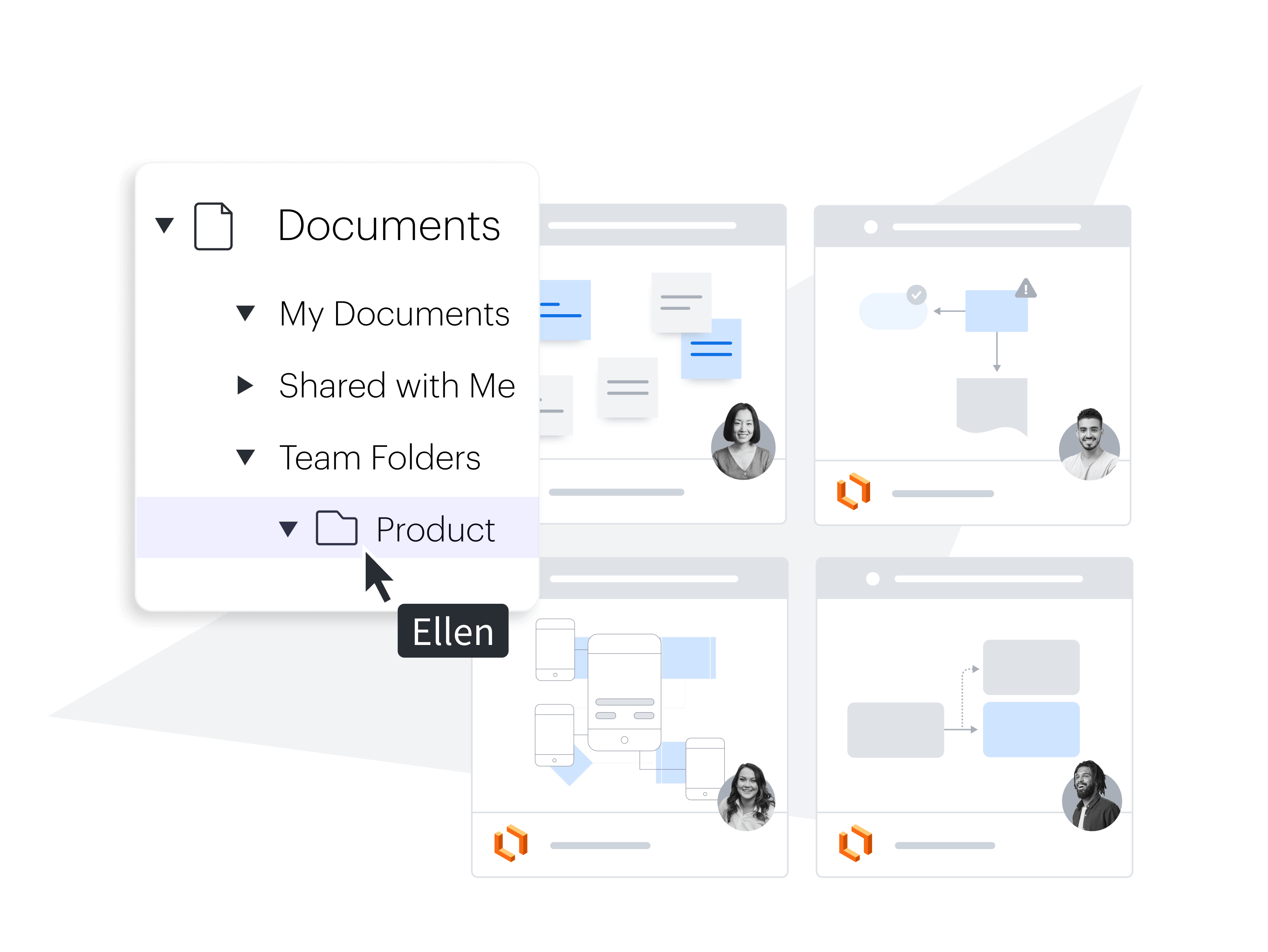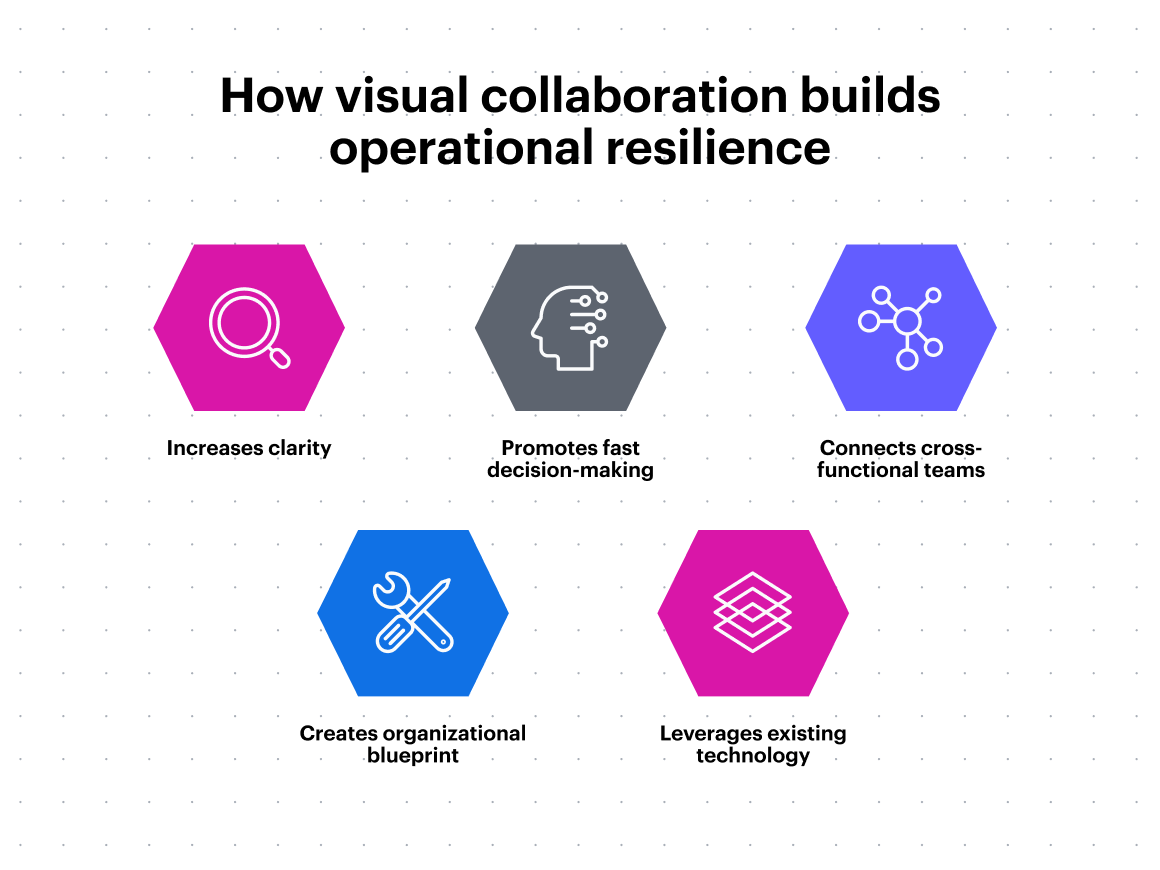
How visual collaboration strengthens operational resilience
Reading time: about 8 min
Topics:
It would be nice if the world—and business—were always predictable. If you could simply create plans and expect nothing to go awry. But we don’t live in that world. And when systems fail, disaster strikes, or a recession hits, businesses are too often left scrambling.
That’s exactly what we’ve witnessed the past few years with the COVID-19 pandemic. Many organizations were unprepared to handle the massive event that shut down entire sectors of the economy and supply chain. But where some failed and floundered, others responded and adapted to meet the moment.
The difference between the two? Operational resilience.
That’s why today, after years of disruption, building operational resiliency has become a top priority for businesses.
There are many ways to address and improve operational resilience, but organizations often overlook one key element: collaboration. Investing in collaboration—that is, enabling collaboration intentionally with the right tools, strategies, and culture—is one of the most important steps organizations can take to increase resiliency across the board.
What is operational resilience?
Operational resilience is the ability to respond to, adapt to, and overcome disruption to business operations. The greater your operational resilience, the faster you can recover when things don’t go according to plan.
As 451 Research describes in a recent webinar, operational resilience is “ the ability of an organization to make good decisions and respond quickly to changing circumstances based on practices, policies, and technologies that support an operational culture of trust, autonomy, and alignment.” Operational resilience involves a variety of initiatives focused on risk management, risk monitoring, and continuity management to protect critical operations and core business lines.
Sounds great, right? Unfortunately, the gulf between this aspirational state and the current state of operational resilience is significant—leaving many organizations at risk.
Challenges to achieving operational resilience
Virtually all organizations understand the importance of operational resilience. But many still struggle to achieve it. The pandemic highlighted and introduced a number of challenges that businesses will need to address in order to improve decision-making capabilities and manage disruptions successfully.
In a recent 451 Research survey, employees shared some of their top challenges and concerns in today’s hybrid workplace.
Getting on the same page as colleagues
Organizational alignment is an ongoing challenge. Businesses today are increasingly complex—made even more so by the modern hybrid workplace. With countless processes and tools to manage and teams spread across locations and time zones, getting everyone on the same page isn’t easy.
This problem can manifest in a number of ways, such as:
- Missed deadlines
- Difficulty accessing the right information
- Wasted time in unproductive meetings
- Being unable to eliminate or address dependencies
And poor organizational alignment doesn’t just impact operational efficiency–it can lead to lower engagement and ultimately stalled growth.
Staying focused and engaged in work
Engagement is the third leading challenge reported by hybrid employees. For every three employees who report higher engagement since before 2020, two employees are less engaged.
There are multiple reasons for this. Despite the many benefits of a flexible, hybrid work model, it also introduces unique challenges. For example, working from home often means more distractions—whether that’s noisy children, dogs that need walking, or the siren call of snacks in the kitchen.
Plus, remote and hybrid work has led to more virtual meetings and what many call “Zoom fatigue.” Distractions, fatigue, and simply more time spent in meetings can quickly impact employee engagement and efficiency.
Finding and sharing information
Another challenge for hybrid employees today is finding and sharing information with each other. Information is often scattered across various tools, platforms, and teams. This challenge is further exacerbated in a remote or hybrid work model where employees can’t easily walk over to a team member’s desk (and may not even work during the same hours).
Additionally, information overload can also derail employee collaboration. Collaboration is about having the right people align on the right goals armed with the right information. But today, workers are dealing with more data than ever before, which can overwhelm them as they try to sift through what matters and what doesn’t. And when they do identify relevant information, sharing it with the right people isn’t always easy.
Getting clarity into work goals and responsibilities
Another challenge related to organizational alignment is ensuring employees understand their work goals and responsibilities. Without clarity on what you are doing and why, it’s nearly impossible to meet performance benchmarks and collaborate in a way that moves your business forward.
Yet only 61% of employees feel they understand the specific goals of the company. Clarity on shared goals and individual responsibilities is essential for building operational resiliency across the board.
Having the right workflows to be effective
With workers distributed across offices and locations, streamlining workflows is a challenge. Coordinating who does what and when—especially across cross-functional teams and siloed departments—is essential for efficient operations. Many businesses are now looking to level up from years of static, synchronous screen shares and persistent information siloes.

Business Impact Brief
Read the full 451 Research Business Impact Brief to uncover all findings.
Check it outCollaboration is the root cause of these challenges
These present-day challenges many organizations face are symptoms of a bigger problem: poor collaboration. Without strong collaboration among employees and leadership, there is a higher risk of miscommunication, disruption, and delayed, confused, or misaligned responses.
And the problem is pervasive: A staggering 65% of employees struggle with collaboration. Their top challenges include:
- Not enough time for collaboration: Misalignment on priorities, workloads, and relevant meetings can suck up valuable time that employees could be using to collaborate. Lucid’s data shows that on average, employees are wasting five hours per week searching for information related to projects.
- They don’t know who to collaborate with: Lack of clear roles, goals, and strategic objectives across teams makes it difficult to identify the right people to connect with.
- They don’t have the right tools: Collaboration depends on having the right tools to connect, share, and innovate. That’s why 29% of employees would likely accept a job elsewhere if the only difference was a better workforce tool stack.
- They’re not allowed to collaborate: Organizational siloes enforced by poor leadership and strict bureaucracy can prevent meaningful collaboration among employees. In a recent Lucid survey, 36% of employees say that talented staff members are leaving organizations due to alignment problems.
To move the needle on operational resiliency, we need to reimagine collaboration. This means moving from static, traditional collaboration efforts to high-value collaborations that are asynchronous, engaging, intentional, and action-oriented.
So how can you do that? Through visual collaboration.

How visual collaboration builds operational resiliency
High-value collaboration doesn’t happen overnight. Businesses need to implement an intentional collaboration strategy via visual collaboration and living documentation.
Visual collaboration drives innovation by using visuals to enable immersive productivity, greater transparency, and increased alignment. Through visually intuitive software, tools, diagrams, and virtual whiteboards, visual collaboration increases focus, helps teams communicate complex ideas, and centralizes information to break down communication siloes.
And it really works. In recent survey commissioned by Lucid, 69% of workers stated that visuals are extremely or very important for collaboration, and 30% of workers agreed that visuals are the key to quicker alignment and quicker task completion.
Build operational resiliency through a visual collaboration strategy that:
Increases clarity
As businesses grow increasingly complex, workers must manage information overload. This entails sifting through data to uncover what information they need, prioritizing that data, and identifying actionable next steps. Manual, tedious work like this takes away from more high-value collaboration activities like brainstorming and problem-solving.
Visual collaboration strategies can help relieve this burden by increasing clarity. Visuals help break down complex ideas and provide living documentation that ensures everyone has the most up-to-date information.
Promotes faster decision-making
Visuals are easier to digest and decipher than text, helping individuals and teams quickly understand ideas and take action. And with visual documentation of technical systems, ideas, plans, and priorities, team members have the information they need to make informed decisions.
Visual collaboration also fuels collaborative decisions through interactive activities. Because turning qualitative feedback into actionable insights is often a bottleneck for quick decisions, visual collaboration can be a powerful solution through features like this.
Enables cross-functional team success
One of the biggest barriers to high-value collaboration is organizational siloes. Businesses that can effectively bring the right people together to solve problems and innovate new ideas will be better prepared to respond to disruption. Visual collaboration can help by enabling cross-functional team success across the entire project lifecycle. Visuals like shared diagrams, virtual whiteboards, and other living documentation can help teams collaborate even when they are in different offices or time zones. Shared visuals make it easy to communicate asynchronously, build on each other’s work, and track team roles, responsibilities, and progress.
Creates an organizational blueprint
The goal of documentation is to centralize an organization’s information and make it accessible throughout the company. Visual collaboration tools let you create living documentation that captures all ideas, decisions, plans, diagrams, and more in one space. When done at scale, you can work towards a live interactive blueprint that employees can reference to understand core systems, priorities, structures, and operations. This helps build alignment and ensures employees have access to the most updated information.

Leverages existing tech stacks
Lots of software typically means lots of siloed information and data. That’s why businesses are looking to get more value out of their existing tech stacks to create workflows that are meaningful and effective. By integrating existing tools into a visual collaboration solution, organizations can bridge gaps, create a single source of truth, and get more value out of each tool.
With the increased clarity, cross-functional alignment, and living documentation that visual collaboration provides, organizations will be well-positioned to respond to whatever changes come their way. In other words: By investing in collaboration, you can build the operational resiliency needed to stay competitive.

Watch the webinar on-demand to learn more about collaboration strategies for building business resilience
Watch it nowAbout Lucid
Lucid Software is the leader in visual collaboration and work acceleration, helping teams see and build the future by turning ideas into reality. Its products include the Lucid Visual Collaboration Suite (Lucidchart and Lucidspark) and airfocus. The Lucid Visual Collaboration Suite, combined with powerful accelerators for business agility, cloud, and process transformation, empowers organizations to streamline work, foster alignment, and drive business transformation at scale. airfocus, an AI-powered product management and roadmapping platform, extends these capabilities by helping teams prioritize work, define product strategy, and align execution with business goals. The most used work acceleration platform by the Fortune 500, Lucid's solutions are trusted by more than 100 million users across enterprises worldwide, including Google, GE, and NBC Universal. Lucid partners with leaders such as Google, Atlassian, and Microsoft, and has received numerous awards for its products, growth, and workplace culture.
Related articles
How to use dependency mapping to visualize dependencies and boost your team’s agility
Here’s how to use Lucid for dependency mapping and best practices for visualizing dependencies in your workflow.
